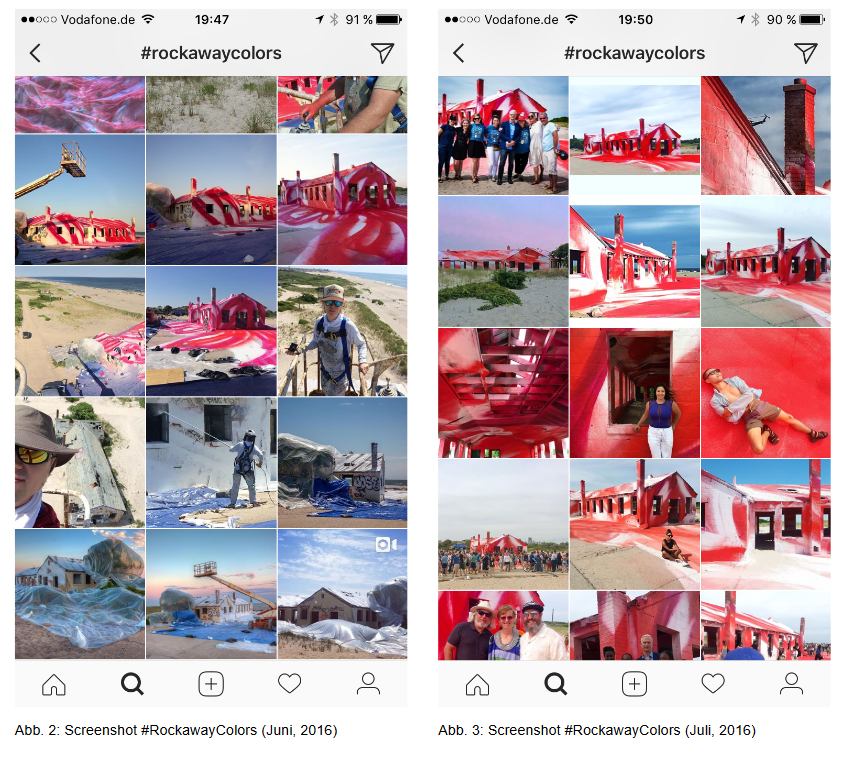Hyperimage
by Jannes Weicht (translated into Englisch by Rebekka Eick)
Etymology
Hyperimage, commonly known as HyperImage, is a term that is also used in the German language. It is a portmanteau word, composed of the greek word “hyper“ (over /above) and the english word “image”. [1]
Definition
The term was introduced by the art historian Felix Thürlemann in 2013. The link is it ́s key element. In hypertext it specifies the data-based networking of various objects. According to Thürlemann, hypertext and hyperimage are complementary. This way, hypertextuality can be brought into analogue space. [2] According to him, a hyperimage is a “calculated compilation of selected objects – paintings, drawings, photographs and sculptures – assembled to a new extensive unity”. [3] Therefore separate images are either originals themselves or photographic reproductions, but for the moment they stay autonomous. [4] By combining (linking) different pictorial objects, such as photographs, a “meaning [is produced…] that can not only been seen as bare addition” [5] on the level of aesthetic reception. This is because the“act of comprehensive seeing provides the observing subject with categories (like young vs old, female vs male, alive vs dead) that can intensify the perception of these two single images – also after actualizing self-reflexive sensing dimensions that are directed at the medium”. [6] Thürlemann puts the origin of the hyperimage down to a western image culture that “has antique and medieval roots, but still only found its shape when the idea of collections was spreading in the beginning of the 17th century”. [7] With this statement Thürlemann mainly refers to so called “Wunderkammern”, which are established cabinets of art and curiosity that, besides images of the currentpresent, also present works from the past intheir spaces. [8]
Instagram as Hyperimage
Using Instagram as an example, scientist of arthistory Maria Männig explains Thürlemann ́s idea of a hyperimage. On that social media platform links are primarily shown by hashtags, as they form “something like the meta-level of a day”. [9] They “allow digital forms of curating, which is possibly one of the most significant forms of acting in the world of social media”. [10] “Orders of hashtags develop hyperimages, which appear as collections of images in grids”. [11] This way, digital images can be read withing the two spheres of hyperimages. One sphere is based on its visual (original) depiction, the other one is based on information that usually appears in a gridded layout and is shown through links. [12]
[1] Cf. Lexikon der Filmbegriffe: Art. Hyperimage.
[2] Männig: Männig, Maria: Instagram als Hyperimage. Hypertext versus Hyperimage. In: Sabine Bartelsheim (Hg.): Hyperimages in zeitgenössischer Kunst und Gestaltung 2, kunsttexte.de, Sektion Kunst, Design, Alltag, Nr. 1, 2017. At: http://edoc.hu-berlin.de/kunsttexte/2017-1/maennig-maria-3/PDF/maennig.pdf (Accessed: 18.02.2019), p. 1.
[3] Thürlemann, Felix: Mehr als ein Bild. Für eine Kunstgeschichte des ,hyperimageʽ.München: 2013, p. 7.
[4] Cf. ibid.
[5] Ibid., p. 8.
[6] Thürlemann, Felix: Bild gegen Bild. Für eineTheorie des vergleichenden Sehens. In: Aleida Assmann, Ulrich Gaier und Gisela Trommsdorff (Hrsg.): Zwischen Literatur und Anthropologie – Diskurse, Medien, Performanzen. Tübingen: 2005, p. 173 – 174.
[7] Thürlemann: Mehr als ein Bild. Für eine Kunstgeschichte des ,hyperimageʽ.München: 2013, p. 8.
[8] Cf. Lexikon der Filmbegriffe: (Art.) Hyperimage. In: Filmlexikon.uni-kiel.de. At: http://filmlexikon.uni-kiel.de/index.php?action=lexikon&tag=det&id=9041 [Accessed: 18.02.2019].
[9] Männig, Maria: Instagram als Hyperimage. Hypertext versus Hyperimage. In: Sabine Bartelsheim (Hg.): Hyperimages in zeitgenössischer Kunst und Gestaltung 2, kunsttexte.de, Sektion Kunst, Design, Alltag, Nr. 1, 2017. At: http://edoc.hu-berlin.de/kunsttexte/2017-1/maennig-maria-3/PDF/maennig.pdf (Accessed: 18.02.2019), p. 2.
[10] Ibid.
[11] Ibid.
[12] Cf. Ibid. p.10.
